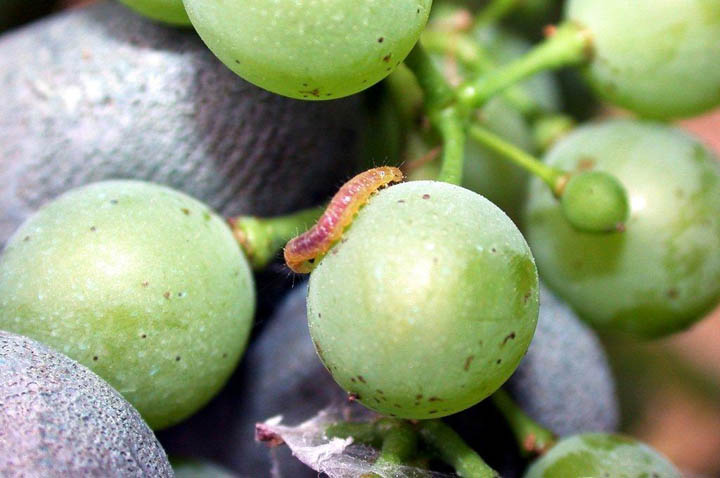
EGVM threatens to be a financial burden
Consequences of allowing EGVM to become established will be financially burdensome to the agriculture industry.As more growing areas fall under the quarantine, greater restrictions will be placed on movement of plant material (not just grapes) and compliance agreements will be necessary.When considering EGVM treatments, growers should also think about mealybug infestations.
October 15, 2010

We are currently into the fourth generation (fourth cycle of eggs and larvae) for European grapevine moth (EGVM) in Fresno County. However, as of Oct. 4, 2010, no new moths have been trapped. Projections identifying this generation were made based on the degree day model developed in Italy and currently being validated in Napa County by Lucia Varela (UC IPM) and Monica Cooper (UCCE).
Based on this model, applied when the first moths of the second generation were caught on June 10, third generation moths should have been present during the last 10 days of July. No moths were found validating the third generation or the start of the fourth generation in Fresno County.
This is not surprising given the intensive management strategies organized by Fresno’s Ag Commissioner, University of California researchers and the industry once the small population of moths had been found. At present, the grape industry is in a good position to eradicate European grape vine moth in Fresno County. But, it is extremely important to “put our foot on the neck of this invasive pest.”
That means timing UC approved EGVM pesticide applications to the core area of EGVM infested vineyards (1000 meter radius of the multiple finds in the Del Rey area) for the fourth generation.
This pest has placed an extreme burden on those who farm grapes in the core area. They are, for all intents and purposes, the ones who are bearing the burden of these multiple treatments. Despite funding received from the Natural Resource Conservation Service Integrated Pest Management Program to cover the chemical cost, the time and effort required to make special treatments has been covered by grape farmers in the core area. However, the consequence of allowing EGVM to become established in Fresno County will be a financial burden to the industry if the quarantine continues.
As more growing areas fall under the quarantine, greater restrictions will be placed on movement of plant material (not just grapes) and compliance agreements will be necessary.
Raisin and wine grape farmers growing crops where the margin for profit is less than for table grapes will be particularly impacted. The table grape industry will also be impacted, with grapes destined for export having mandated fumigations.
The need to eliminate this pest from Fresno County is critical. Don’t delay treatments; there are multiple products available.
When considering EGVM treatments, growers should also think about mealybug infestations. Hand harvested fruit is often left behind by pickers when heavy mealybug infestations are present. Where vine or grape mealybug have resulted in severe crop damage, those clusters must be removed and destroyed and not remain in the vineyard to be infested by late developing EGVM. Growers should select products that have a long residual for EGVM if high mealybug populations are present.
For information on the biology and damage potential for European grapevine moth, see www.ipm.ucdavis.edu/EXOTIC/eurograpevinemoth.html. A map is available to growers delineating the quarantine area of 96 square miles and the core 1000‐meter radius from the central find.
Trap monitoring will continue through the efforts of the Fresno County Agriculture Commissioner’s office and the California Department of Food and Agriculture.
In the core EGVM infested area this means traps are at a density of 1 per 5 acres. This is intensive trapping and it is important in determining the active EGVM population in Fresno County. Even with this trap density, not finding a moth or larva doesn’t mean there are no EGVM life stages present and that means we need to continue the eradication effort. We do believe this pest will be eradicated. You should believe that as well.
Walt Bentley is a UC IPM advisor located at the UC Kearney Agricultural Center. Stephen Vasquez is a UC Cooperative Extension farm advisor in Fresno County.
You May Also Like



